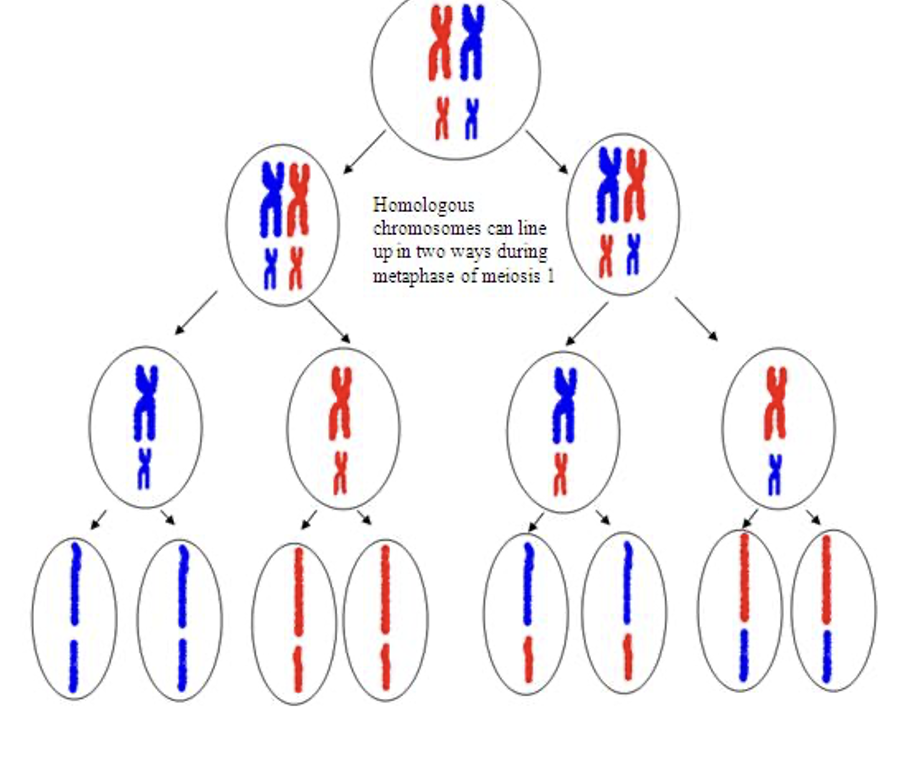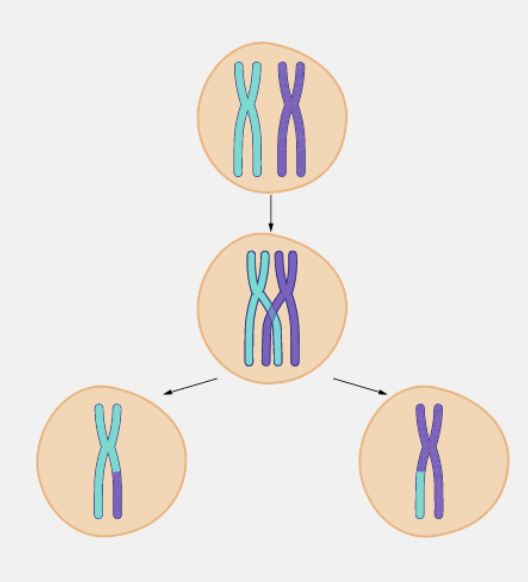Y10 T3 Science - Evolution
1/41
There's no tags or description
Looks like no tags are added yet.
Name | Mastery | Learn | Test | Matching | Spaced |
|---|
No study sessions yet.
42 Terms
Biodiversity
The variety and variability of species on Earth, which is a function of evolution
Genetic Diversity
The variety of the genes and its alleles in a species, which develops due to mutation. The more of this a species has, the easier they find it to adapt to selection pressures
Species Diversity
The variety of different species that exist in an ecosystem
Ecosystem Diversity
The variety of ecosystems in a specific place
Ecosystem
Community of biotic and abiotic factors that interact with each other to survive
Genetic vs Species vs Ecosystem Diversity
Genetic diversity is the diversity of genes in one species, while species diversity is the diversity of species in one ecosystem, while ecosystem diversity is the diversity of ecosystems in one location
Evolution
The process of which mechanisms drive a species to change over time, which takes millions of years
The Importance of Variation in Evolution
In terms of Genetic Diversity, allows for some members of a population to survive changes to the environment or diseases, which otherwise would affect the entire population. This resistance to the change/disease some members of the species have is then able to be spread to the rest of the species
In terms of species diversity, allows ecosystems to survive changing populations of species, like if one prey organism goes extinct, predators still have access to other prey. Allows for the different species of the ecosystem to evolve and adapt to different conditions
Independent Assortment
A process that increases variation, in which maternal and paternal chromosomes are randomly distributed to each daughter cell.
(to clarify: means that each daughter cell has the same amount of chromosomes, but have a random mix of how many of the chromosomes are originally from the mum, and how many are originally from the dad)

Recombination
Also known as crossing over, a process that increases variation where homologous chromosomes come into contact and swap a certain part, meaning the chromosomes trade the alleles each have

Mutation
A change in the DNA sequence, and a key function of evolution as it is the only way to increase genetic diversity. Can increase variation if change occurs in a gamete, though usually doesn’t affect genotype or phenotype (but can). Has 3 types.
3 Types of Mutation
Point mutation - Where a single nucleotide added, removed, or substituted in a chromosome
Chromosomal Mutation - where certain parts of a chromosome are inverted, deleted, duplicated, or translocated (moved)
Copy Number Variations - where certain parts of DNA are repeated more than once, and this amount of times it is repeated gets increased or decreased
Environment’s effects on Phenotypes
The environment of an organism has a great affect on how an organism looks. If an organism has poor nutrition, is exposed to too much sunlight, etc., it’s genes/alleles will not change (meaning there is NO increase of variation), but it will look different.
Basically, the environment can cause a change in the phenotype, but not a change in the alleles/genotype
Population
The amount of individuals in a species in a location at a specific time and place
Gene pool
The combination of all genes and alleles present in a population
Relationship of Gene Pool and Population
Both are ways to measure or describe members of different types in a species in a certain area
Allele Frequency
The rate that organisms in a species get alleles of a gene. For example, the rate a frog gets green skin colour may be 75%, while the rate it gets blue skin colour may be 25%
Natural Selection
A mechanism of evolution in which organisms in a species are introduced to selection pressures, which cause only some members to be able to survive/reproduce. Those with the best genes suited to these selection pressures survive and reproduce more often, passing on the more effective genes (basically survival of the fittest)
Gene Flow
A mechanism of evolution where an organism/s from one population enters another population, spreading it’s genes/alleles. For example, green bug entering a population of yellow bugs, eventually making half the bugs green
Genetic Drift
A mechanism of evolution where the gene pool randomly changes causing a species to evolve, usually being a random event that kills many members of a species, only allowing the random survivors the spread their genes and make a new population. For example, an earthquake killing most birds with red stripes, making birds with black stripes more common
Selection Pressures
Things (can be living or non-living) that stop the organisms of a species from being able to survive/reproduce. For example, pollution, predators, disease, temperature, etc.
How Gene Pools Change over Time due to Natural Selection
Selection pressures can greatly affect a species, potentially leading them to extinction. After a while, the species will begin developing traits more resistant to these pressures, meaning the gene pool becomes filled with mainly these better alleles.
For example, the peppered moth in the 1850s was white as it hid on white trees, though sometimes were born black. When trees turned black due to pollution in the 1900s, the black body allele became more common in the gene pool.
For example, when a human uses antibiotics, the meds kill most but not all of the bacteria. The surviving bacteria quickly breeds and recreates a colony, filled with more bacteria resistant to the antibiotics. The gene pool becomes filled with a resistance to antibiotics
Artificial Selection
The process by which humans selectively breed species to give them desired characteristics, meaning people are the selection pressure. This can be seen in domesticated pigs, who have been bred to heel more meat, and modern bananas, which have been bred to minimise/remove their seeds
Natural Selection vs Artificial Selection
Natural selection goes over thousands of years and is driven by certain selection pressures that force a species to develop better traits to survive. Artificial selection goes over a couple generations and is driven by humans breeding for specific characteristics in a species
Species
Groups of organisms that are able to produce fertile offspring together
Speciation
The process by which new species are created
Fossil
A preserved trace of an organism that lived long ago, and can been seen in things like skeletons, footprints, impressions, etc.
Process for Fossilisation to occur
Organism is buried in sand/mud/dirt (prevents any damage or disruption)
Organism is further buried by water/dirt/mud to put it under higher pressure (allowing minerals to enter hard parts of body and turn it into stone)
Soft parts are not generally not preserved and are lost (but can leave imprints)
Organism is found later, generally in sedimentary rock
How Fossils support Theory of Evolution
The age of fossils can be found through processes like carbon dating, which allow scientists to prove that some species existed in certain areas and changed over time. Through this, scientists are able to prove that the fossils were the ancestors of other organisms
Comparing DNA
The process where the DNA of different species are analysed for their similarities and differences. The more closely related their DNA is, the more recently they split off from a common ancestor. Works as originally two species were one, and their genes slowly changed and mutated, becoming more and more different over time
How Comparing DNA supports the Theory of Evolution
As through comparing DNA, you are able to show the similarities in the genetic codes of different species. These arise from having a common ancestor, and the DNA of the species that diverge from it changing the genes and alleles slightly over time
Proteins
Long chains of amino acids. Genes provide instructions for the number and order of amino acids in them
Comparing Proteins
The process where the same proteins of different organisms are compared. As some proteins exist across multiple species (like cytochrome c), you can analyse the difference in the sequence amino acids between them, allowing you to show how closely related they are
How Comparing Proteins supports Evolution
As through comparing proteins, you are able to discover how closely related two species are through the sequences of their amino acids. The similarities in the sequence of proteins help prove that organisms were once related, and changed slowly over time
Homologous Structures
Structures in different organisms that are similar, which result from divergent evolution. For example, the pentadactyl limb (hand thing with five parts), which the ancestor of all mammals had, is now present in all mammals. Includes the similar structure of the arm and the hand, and is found in whales, humans, bats, every mammal.
How the Pentadactyl Limb Supports the theory of Evolution
As it shows a common relation between all mammals, proving they all had a common ancestor at one point from which they evolved from, adapting the pentadactyl limb to their needs (to become a fin, a wing, a hand, etc.)
Vestigial Organs
A structure in an organism which serves no purpose, not being a good or bad thing and as a result, never being bred out. Results from divergent evolution. Can be seen in hind legs on snakes, tail bones in humans, and pelvis on whales
Relationship between the stages of embryos and the relatedness between different species
The early stages of the embryos of different species have many similarities with each other, especially homologous structures, which show how these species came from a common ancestor, and thus are related. For example, many embryos (e.g., humans, pigs, fish) have tails and gills, even if the fully formed embryo doesn’t use them
How Embryology supports the Theory of Evolution
As through comparing the embryos of different species, you are able to find various vestigial and homologous structures between different species. This can be seen in things like human embryos having gills and tails, and horse embryos having ”fingers”, suggesting that these species were once related to a common ancestor which had embryos with gills, a tail, and ”fingers”
Biogeography
The study of where organisms live, and why
How Biogeography supports the Theory of Evolution
As through this, you can see that some ancient organisms that looked similar to modern organisms, lived in similar areas. This suggests that the ancient organism was an ancestor to the modern one. Similar animals in different continents can be explained by continental drift, suggesting that all of these animals also had a common ancestor, but were split off from it (e.g., ratites)
Process of the Formation of a New Species
Variation - where a species is very genetically diverse
Natural Selection/Genetic Drift - where selection pressures or a random event causes only those with the traits to survive to pass on their genes
(both change allele frequency)
Evolution accumulates over time - slowly, the species becomes more and more different than the original population
New species is formed - the new population can now now longer mate and make fertile offspring